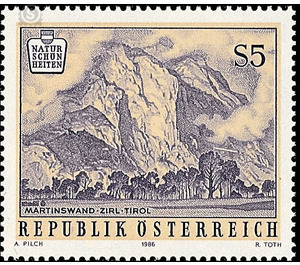nature - Austria / II. Republic of Austria 1986 - 5 Shilling
Theme: Geology & Geography
| Country | Austria / II. Republic of Austria |
| Issue Date | 1986 |
| Face Value | 5.00 |
| Color | violet |
| Printing Type | combination printing |
| Stamp Type | Commemorative |
| Item Type | Stamp |
| Chronological Issue Number | 1194 |
| Chronological Chapter | OOS-OE2 |
| SID | 882853 |
| In 65 Wishlists | |
As an unmistakable landmark of the market town Zirl, the mighty Martinswand towers to the sky in the east. It belongs to the Solstein group in the Karwendelgebirge, a part of the North Tyrolean Limestone Alps. It rises steeply on the left bank of the Inn to a height of 1,113 m. The Wetterstein limestone from which it is made, is a chemically very pure and karst prone limestone, which holds many small cavities and sometimes larger caves. In the Ice Age, the wall was sanded hard by the mighty Inntal Glacier and rounded the surrounding mountains. The wall is also the border between the upper and the lower Inn valley. In 1932, the wall was first climbed by Hias Auckenthaler and Hans Frenademetz. In the middle of the steep wall is the famous Martinswandgrotte, 799 m above sea level. It is also known as Maximilian's grotto, because according to the legend emperor Maximilian had for his rescue in the Martinswand during a hunting party cut out the place of his rescue to a cave and there attach a cross as thanks.


